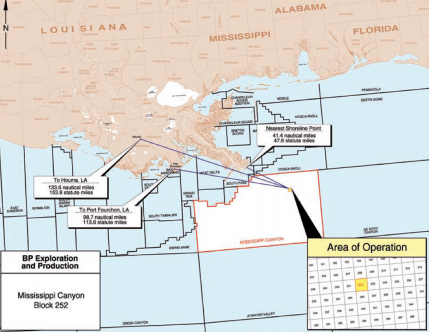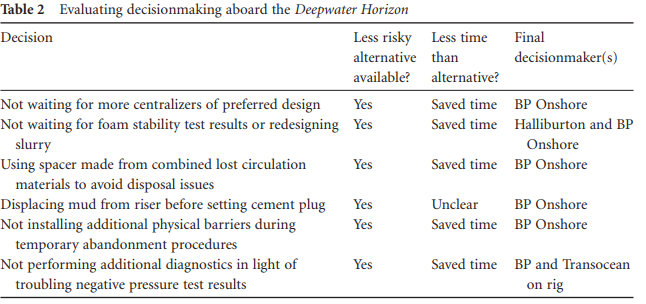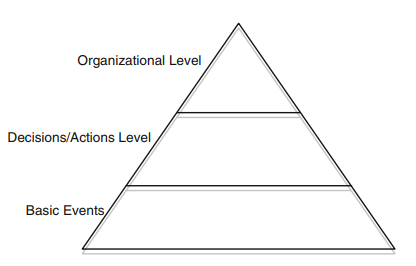Executive Summary
The Deepwater Horizon disaster occurred in 2010 caused severe deterioration of the environment as well as significant financial losses. Organizational and operational factors of several companies involved in oil production led to the accident. It is recommended to improve interaction and cooperation between stakeholders, develop preventive policies and guidelines, and introduce a new organization that would be responsible for monitoring.
Problem Statement
The accident occurred in Mexican Gulf in 2010 affected the environment, economy, and social life of the US. The problem is that the Deepwater Horizon disaster accident was caused by errors in the management of companies involved in the development of the field, including weak safety measures, changes in organizational issues and leadership as well as Macondo Well project’s multiple mistakes and repairs of the platform. The experts detected that various repairs required immediate attention. The combination of the above factors caused the mentioned accident.
Data Analysis
Reviewing the case study by Ingersoll, Locke, and Reavis (2012), it becomes evident that the violations were systematic. In particular, British Petroleum (BP) did not have adequate response measures to ensure safety, including the inability of workers to identify the first signs of an imminent accident. It should be emphasized that BP management stated that the report of the presidential commission along with the company’s own investigation conducted in September 2010 coincides with the conclusion that the responsibility for the accident in the Gulf of Mexico lies on several companies, including BP, Cameron, Halliburton, Anadarko, Hyundai, and Transocean. Figure 2 shows that three organizational layers were found responsible for this case: Basic events, decisions, and organizational level. In September 2011, a joint report of the US Coast Guard and the Office for World Ocean Affairs and International Problems in the field of environment and science on the causes of the accident on Deepwater Horizon platform in the Gulf of Mexico confirmed the findings of the government commission (Tabibzadeh & Meshkati, 2014). It is also critical to point out that the defects in cementing the well on which the platform worked were also detected.
The identified accident led to a serious environmental disaster. As a result of the oil leakage that lasted almost three months from BP’s emergency well into the waters of the Gulf of Mexico, about 206 million gallons of black gold was lost (see Figure 1). After the oil spill, thousands of claims for damages were filed in the courts, and the main defendants were Transocean and BP. In November 2012, BP pleaded guilty to the death of 11 people and agreed to pay a fine of 4.5 billion dollars for an oil spill in the Gulf of Mexico (Dadashzadeh, Abbassi, Khan, & Hawboldt, 2013). It was BP, Halliburton, and Transocean solutions that increased the risk of a Macondo well breakthrough, thereby saving companies a lot of time and money. In addition, BP was accused of mistakes during the elimination of oil leaks from the emergency well (Starbird et al., 2015). In particular, miscalculations were noted with cement fluid during the shut-in operation of the well. It was stressed that such an accident can happen again if government reform in the oil and gas industry is not carried out.
Key Decision Criteria
Among the main decision criteria that were taken into account during the operation of the Deepwater Horizon, one may enumerate a rather complicated organizational context and unawareness of safety measures. As it is noted in the case by Williams, the first signs of the disaster were perceived as simulation, and the workers proved to be lacking skills and knowledge on how to act in such cases (Ingersoll et al., 2012). More to the point, it seems that neither the oil industry nor BP thought that the risk will grow when drilling in increasingly difficult conditions as there is a clear underestimation of the threatening dangers (see Table 1). The preventer at Macondo well was also non-functional since one of its pipe dies, the plates covering the drill string and intended not to allow gases and liquids rising through the preventer, was replaced by a non-working pilot (Mills & Koliba, 2015).
Alternatives Analysis
Since the mentioned disaster was caused by a range of decisions in several fields, it is possible to suggest that some alternatives might prevent it. The initial accident and explosion on the Deepwater Horizon platform could have been avoided if the safety alarm had triggered (Reader & O’Connor, 2014). According to BP company representatives, the siren was turned off so as not to disturb the sleep-dropping team after the shift. Another alternative refers to the promotion of greater collaboration between organizations involved in the process of oil production. If they might coordinate their responsibilities or, for example, agree on shared accountability, the problem would be eliminated due to timely monitoring and repair of systems.
Recommendations
In the view if the given case study, the pivotal goal is the prevention of similar accidents in the future. To effectively reduce such threats, it is necessary to develop space monitoring and ground-based research related to a qualitative rather than formal assessment of the impact of oil production on the environment. With the aim of achieving a balance between the desire to increase production and compliance with measures to protect natural resources, one may suggest that the federal government should create such a system of verifications that would reveal any errors. One more solution is associated with the creation of an international organization that would consider such issues by providing regulations, guidelines, and other preventive and punitive measures.
Action and Implementation Plan
To prevent such an accident, it is necessary to not to start new large-scale projects, unless a high environmental security guarantee is technologically provided. The analysis shows that reducing costs inevitably leads to the deterioration in security. Therefore, in the event of a disaster in the Gulf of Mexico, it is important to note that the final test of the cement plug was canceled, the defect of which led to the destruction of the platform (Tabibzadeh & Meshkati, 2014). In addition, employees of companies did not make independent decisions, which indicate the significance of employee training and education. In the case of the Deepwater Horizon, the platform employees did not take responsibility for the activation of the emergency warning system, and it should be prevented in the future. In general, there is a need to elaborate a comprehensive plan that should take into account organizational and operational issues and address all factors that were mentioned in this paper. The control from the government and related bodies seems to be essential to monitor errors and prevent disaster in the oil industry.
References
Dadashzadeh, M., Abbassi, R., Khan, F., & Hawboldt, K. (2013). Explosion modeling and analysis of BP Deepwater Horizon accident. Safety Science, 57, 150-160.
Ingersoll, C., Locke, R. M., & Reavis, C. (2012). BP and the Deepwater Horizon disaster of 2010. MIT Sloan School of Management, 3, 1-28.
Mills, R. W., & Koliba, C. J. (2015). The challenge of accountability in complex regulatory networks: The case of the Deepwater Horizon oil spill. Regulation & Governance, 9(1), 77-91.
Reader, T. W., & O’Connor, P. (2014). The Deepwater Horizon explosion: Non-technical skills, safety culture, and system complexity. Journal of Risk Research, 17(3), 405-424.
Starbird, K., Dailey, D., Walker, A. H., Leschine, T. M., Pavia, R., & Bostrom, A. (2015). Social media, public participation, and the 2010 BP Deepwater Horizon oil spill. Human and Ecological Risk Assessment: An International Journal, 21(3), 605-630.
Tabibzadeh, M., & Meshkati, N. (2014). Learning from the BP Deepwater Horizon accident: Risk analysis of human and organizational factors in negative pressure test. Environment Systems and Decisions, 34(2), 194-207.
Exhibits


